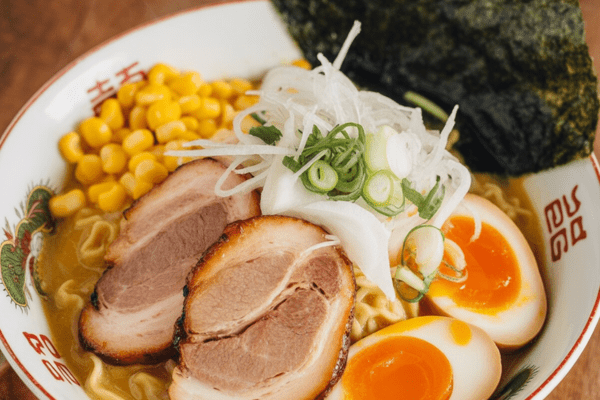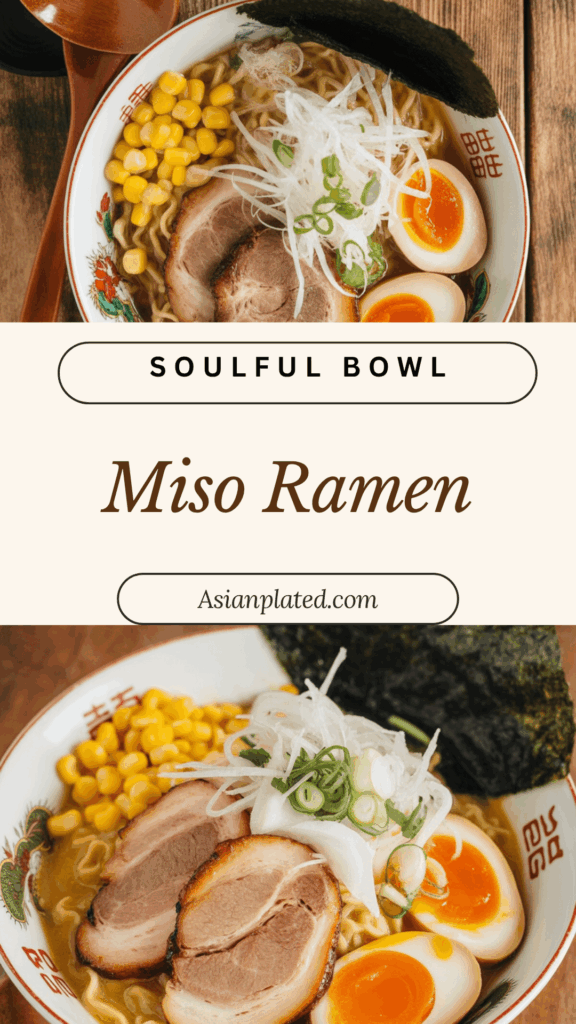If you’ve ever craved a steaming bowl of soulful, slurp-worthy noodles that hugs your insides, miso ramen is that kind of comfort food. It’s rich, savory, and packed with layers of umami thanks to the miso, sesame, and spices. The best part? You don’t need to simmer bones all day to enjoy a deeply satisfying bowl — this one comes together in under 30 minutes.

What is Miso Ramen?
In Japan, ramen comes in three classic flavors: shio (salt), shoyu (soy sauce), and miso (fermented soybean paste). Miso ramen, the heartiest of the three, gets its signature taste from a miso-based broth that’s nutty, earthy, and a little creamy. Unlike tonkotsu, which is pork-bone heavy and takes hours to prepare, this one is far more approachable for home cooks.
Today, I’ll walk you through how to make miso ramen from scratch — soup, noodles, and toppings — in a way that’s totally doable on a weeknight. Let’s break it down.
Ramen Soup (The Soul of the Bowl)
I grew up eating instant noodles during college days, but once I started making this 15-minute miso broth, there was no going back. Unlike the powdered seasoning packets, this broth feels real — rich, complex, and layered.
Now, don’t confuse this with traditional miso soup. This ramen broth is bolder and heartier, thanks to a few key ingredients.

5 Must-Have Ingredients for Miso Ramen Broth
1. Miso Paste
Miso gives the broth its depth. I usually go with white or mixed miso — they’re well-balanced and not too overpowering. You can experiment with red miso for a bolder flavor, but steer clear of varieties like hatcho miso which are too intense for this dish.
2. Doubanjiang (Fermented Bean Paste)
This Chinese paste adds that extra layer of umami — spicy or non-spicy versions both work. I tend to use the non-spicy version when making ramen for kids, but if you’re up for heat, go with the spicy Sichuan version. A little goes a long way.
3. Sesame Seeds + Toasted Sesame Oil
Crushing toasted sesame seeds (I just use a rolling pin or mortar) and adding dark sesame oil makes the broth irresistibly nutty. It’s what gives miso ramen that extra richness.
4. Chicken Broth
If you have homemade chicken stock in the freezer, lucky you — use it. Otherwise, a good-quality low-sodium store-bought broth will do. Just adjust your salt accordingly.
5. White Pepper Powder
It’s subtle but makes a difference. A few pinches of white pepper warm the broth without making it spicy. I always keep a jar around for soups and stir-fries.

Ramen Soup FAQs
Can I skip sugar in the soup?
Actually, the sugar isn’t meant to sweeten it — it balances out the saltiness of the miso and doubanjiang. Start with a teaspoon and taste your broth before adding more.
Is sake necessary?
If you can use it, yes. Sake helps mellow out any meatiness in the broth and adds a depth that’s hard to replicate. If not, try a splash of dry sherry or Chinese cooking wine.
Ramen Noodles (The Chewy Base)
Ramen noodles are special — they’re made with wheat flour and kansui (alkaline water), which gives them that bouncy, slightly chewy texture. While they look yellowish, they’re not egg noodles.
Types of Ramen Noodles You Can Use
1. Fresh Ramen Noodles
Fresh noodles are always my first choice. I usually stock up at an Asian grocery store. If you’re lucky, you might find brands like Sun Noodle or house-made packs at specialty markets.
2. Dried Ramen Noodles
Can’t find fresh ones? Go for dried Japanese ramen noodles. They’re not quite the same but still a solid option — better than instant noodles with soup powder.
3. Gluten-Free Option
There are rice-based ramen noodles available now that mimic the texture of wheat noodles really well. I’ve tried some from specialty Japanese brands and they’re surprisingly good.
Tips for Cooking Ramen Noodles
- Use a big pot of water to give the noodles room to move.
- Don’t salt the water — ramen isn’t pasta!
- Prep everything before boiling, because ramen noodles cook fast — once they’re ready, serve within 30 seconds to avoid sogginess.
Ramen Toppings (The Finishing Touch)
Here’s where you can get creative. While the broth and noodles are non-negotiable, toppings can be anything you like — and they really make each bowl feel personalized.
Classic Toppings I Use:
- Chashu Pork – slow-braised belly slices are a must if you’re going traditional
- Ramen Egg (Ajitsuke Tamago) – jammy-centered and marinated in soy-based sauce
- Menma (Seasoned Bamboo Shoots) – adds a nice crunch
- Shredded Leeks or Green Onions – fresh and sharp
- Narutomaki (Fish Cake) – optional but fun
- Corn Kernels – especially good with miso
- Nori Sheets – for that touch of umami from the sea
Other Topping Ideas:
- Blanched bean sprouts or greens like spinach or bok choy
- Wakame or other seaweed
- Thin slice of butter (for miso butter ramen!)
- Cubed tofu, shiitake mushrooms, garlic chives — the list goes on
I usually prep my toppings a day before if I’m planning a ramen night. That way, I only have to focus on the broth and noodles when hunger hits.
How to Serve
Ladle the hot broth into a deep bowl, add the freshly cooked noodles, then pile on your toppings of choice. Serve immediately while everything’s piping hot. I always place the chashu and ramen egg right on top and finish with a drizzle of sesame oil or chili oil if I’m in the mood.
Storing Leftovers
If you’ve got leftover broth, refrigerate it for up to 3 days or freeze it for up to a month. Keep the noodles and toppings separate — noodles soaked in broth overnight will turn mushy. When reheating, bring the broth to a simmer, reheat the noodles separately in hot water for a few seconds, and assemble your bowl fresh.
Miso Ramen

This quick and delicious miso ramen recipe features an intensely savory broth and comes together in under 30 minutes. With five key broth ingredients, this steaming bowl of comforting goodness is sure to satisfy any ramen cravings.
Ingredients
For the Soup Broth:
- 2 cloves garlic
- ½ tsp grated ginger
- 1 shallot
- 1 Tbsp toasted white sesame seeds
- 1 Tbsp toasted sesame oil
- ¼ lb ground pork (or use meat alternatives/chopped mushrooms for a vegan/vegetarian option)
- 1 tsp doubanjiang (spicy or non-spicy chili bean paste; gluten-free version if needed)
- 3 Tbsp miso (any type except Saikyo and Hatcho)
- 1 Tbsp sugar
- 1 Tbsp sake
- 4 cups chicken stock or broth (vegetable stock for vegan/vegetarian)
- 1 tsp kosher salt (adjust to taste)
- ¼ tsp white pepper powder
For the Ramen Noodles:
- 2 servings fresh ramen noodles (10–12 oz fresh or 6.3 oz dry; gluten-free option if needed)
Optional Toppings:
- Braised pork belly (or omit for vegan/vegetarian)
- Spicy bean sprout salad or blanched bean sprouts
- Ramen egg (omit for vegan)
- Frozen or canned corn, drained
- Nori (cut into quarters)
- Chopped green onion/scallion
- Julienned long green onions (shiraga negi)
Optional Condiments:
- Japanese chili oil
- Pickled red ginger
- White pepper powder
Instructions
- Gather all ingredients.
- Mince or press garlic, grate the ginger, and mince the shallot. Set aside.
- Grind sesame seeds, leaving a few whole for texture. Set aside.
- Heat a medium pot over medium-low heat. Add sesame oil.
- Add garlic, ginger, and shallot. Stir-fry until fragrant.
- Add ground pork and increase heat to medium. Cook until no longer pink.
- Add doubanjiang and miso. Quickly mix to prevent burning.
- Add sesame seeds and sugar. Mix well.
- Add sake and chicken broth. Bring to a simmer.
- Taste and adjust with salt and white pepper as needed.
- Cover and keep the broth simmering while preparing the noodles.
- Boil a large pot of unsalted water.
- Warm ramen bowls with some hot water, then discard the water.
- Loosen the noodles and cook according to package instructions, reducing time slightly for a firmer texture.
- Drain well using a mesh sieve to avoid diluting the broth. Place noodles in warmed bowls.
- Pour hot soup broth over the noodles.
- Add desired toppings.
- Add condiments if using, and serve immediately.
Nutrition Information:
Yield: 2 Serving Size: 1Amount Per Serving: Calories: 1712Total Fat: 76gSaturated Fat: 24gTrans Fat: 0gUnsaturated Fat: 46gCholesterol: 290mgSodium: 5991mgCarbohydrates: 178gFiber: 14gSugar: 34gProtein: 82g
Asianplated.com, occasionally offers nutritional information for recipes contained on this site. This information is provided as a courtesy and is an estimate only. This information comes from online calculators. Although allchickenrecipes.com attempts to provide accurate nutritional information, these figures are only estimates.
Final Thoughts
Once you’ve made your own bowl of miso ramen at home, you’ll understand why it’s such a beloved comfort food. It’s easy, satisfying, and way more customizable than anything you’ll find in a package. So grab your ingredients, build your broth, and enjoy this cozy bowl of goodness — whether it’s a rainy evening or a self-care weekend.
Try other recipes:

